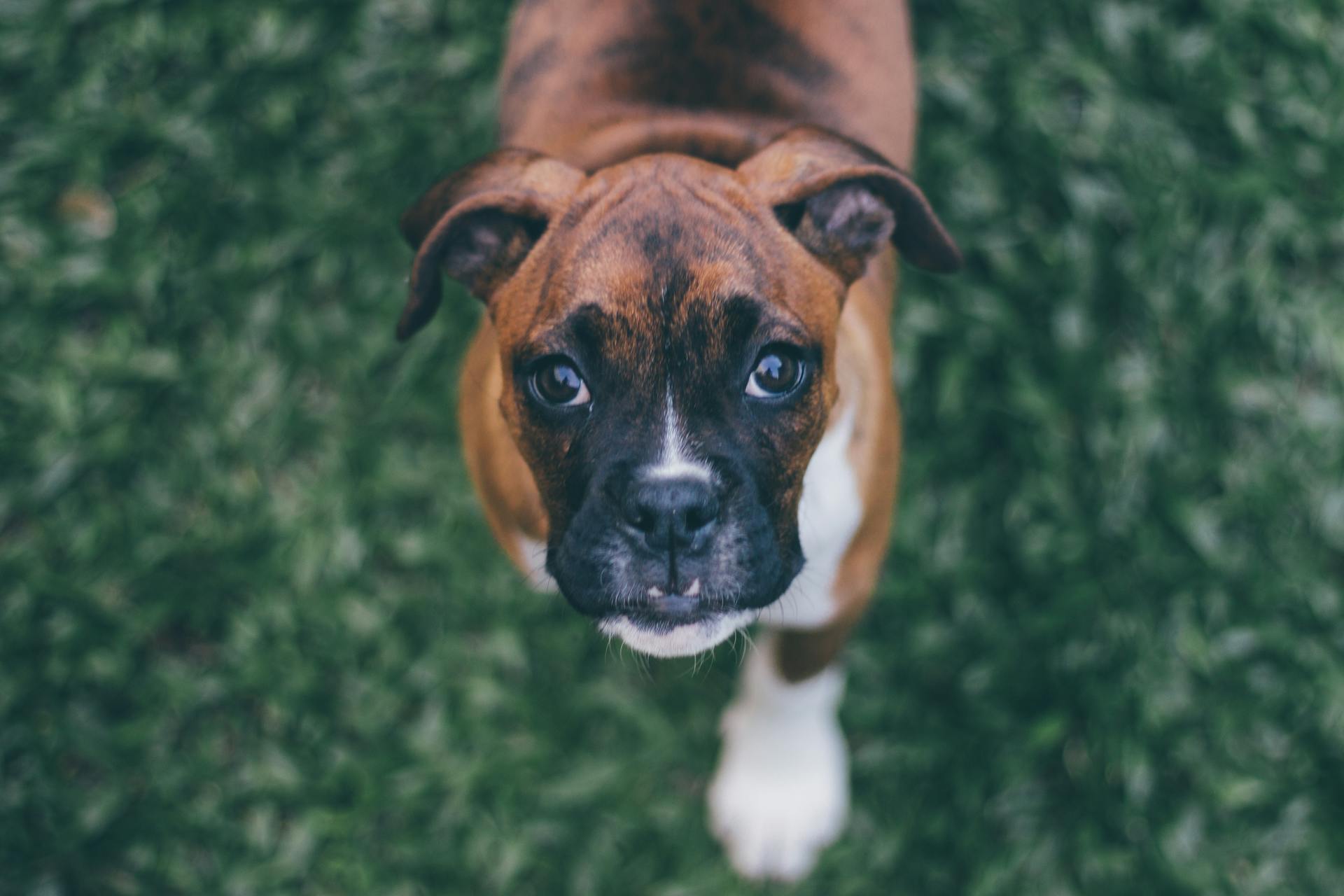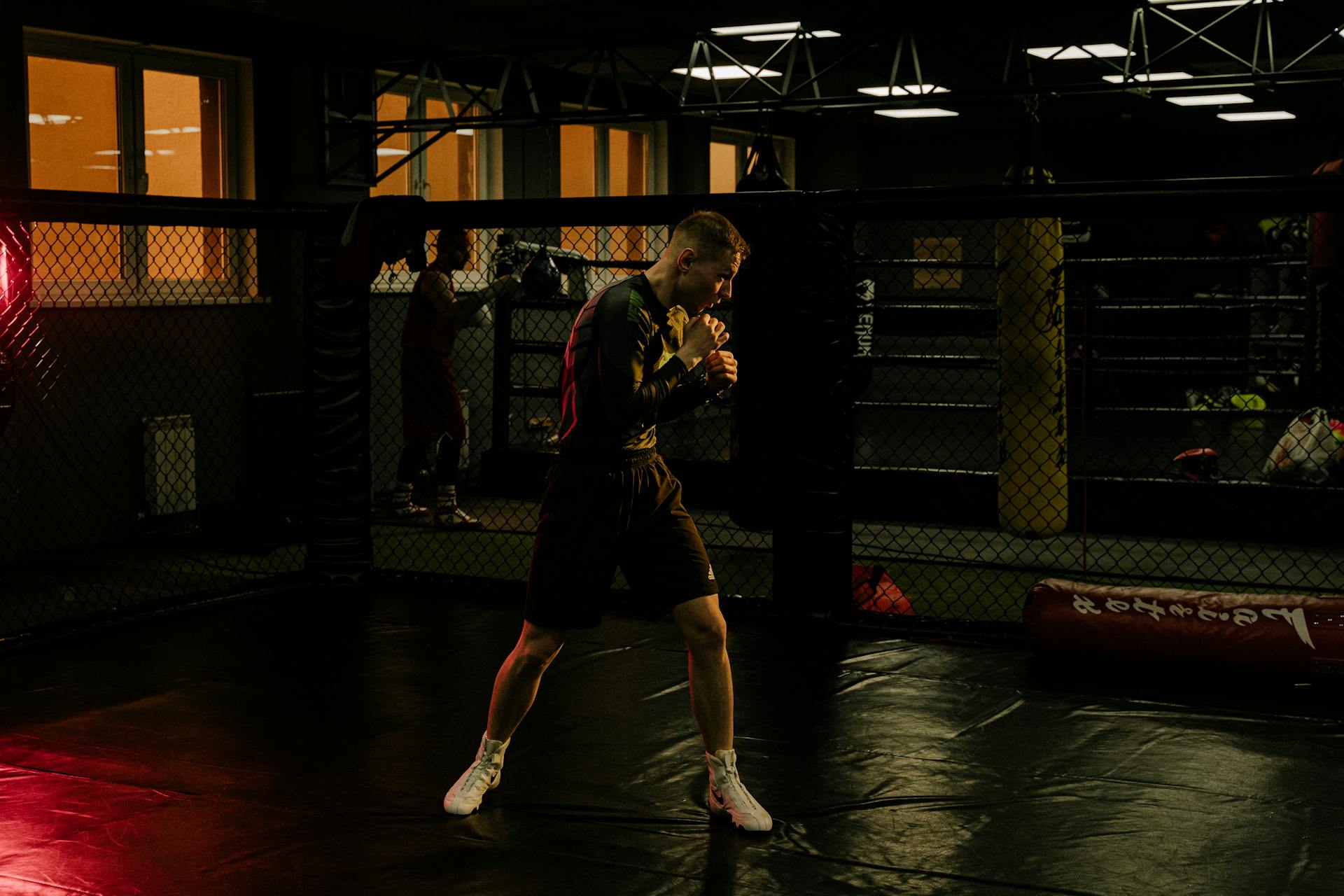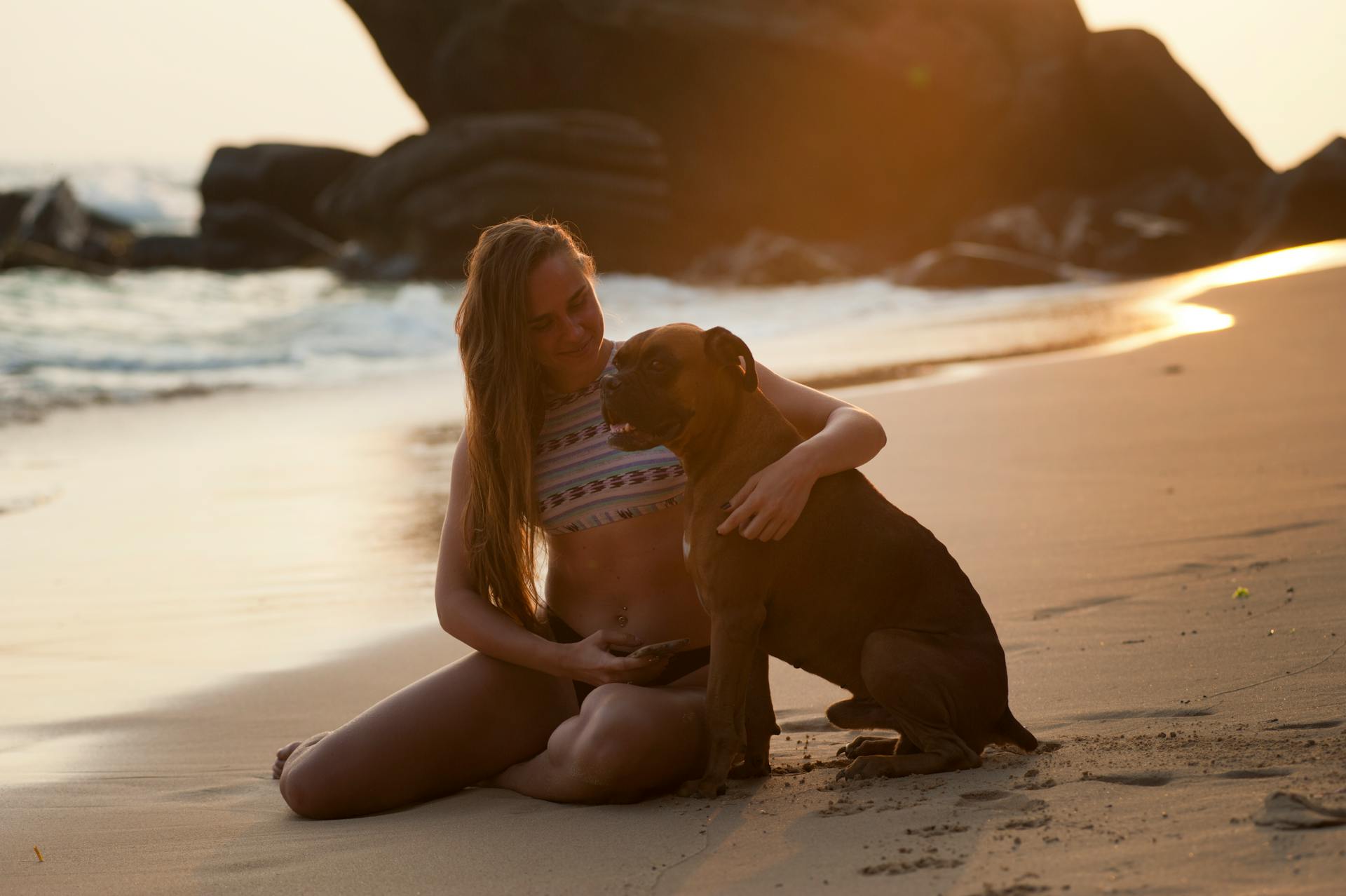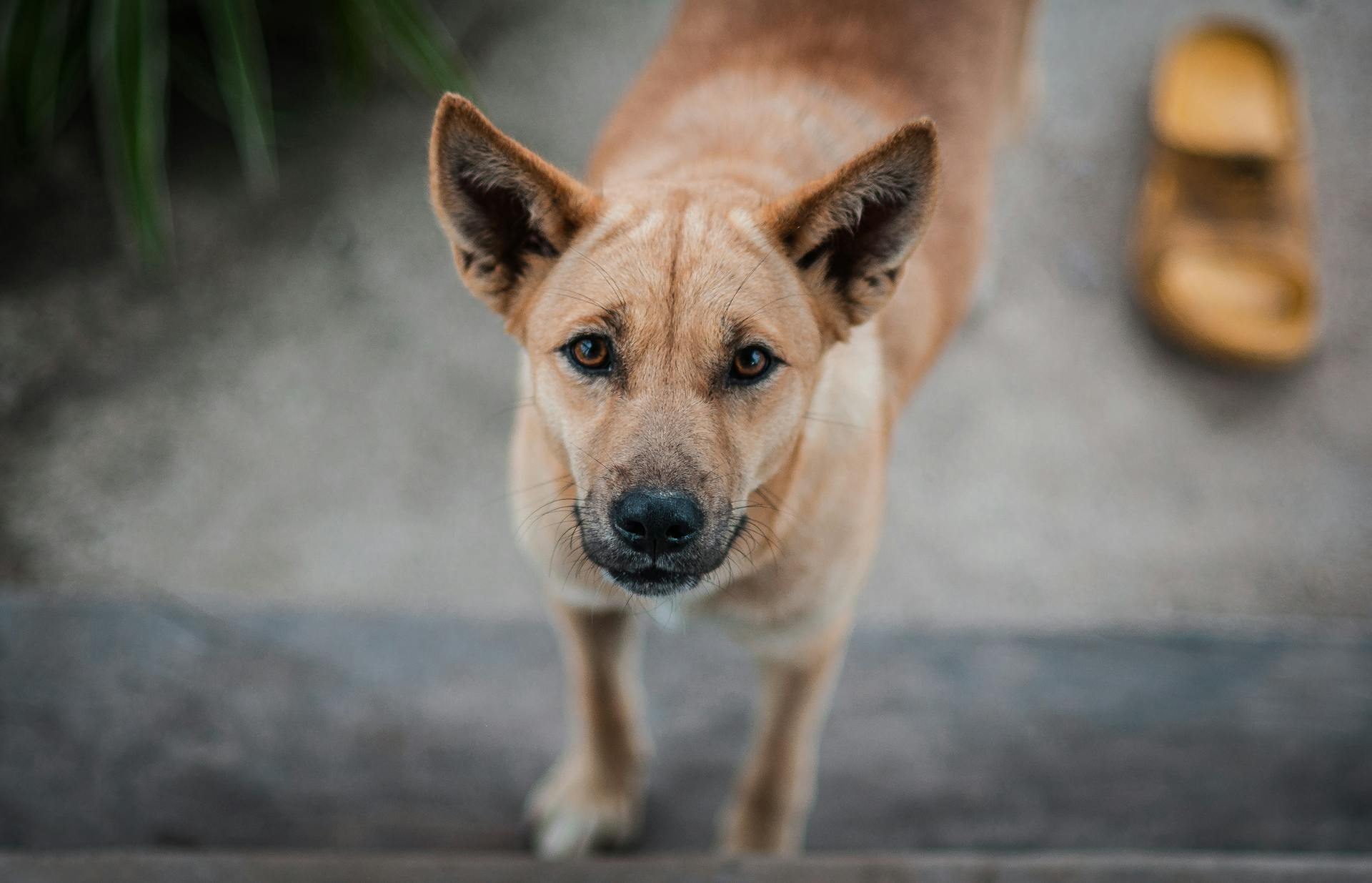
The Boxer Bully breed is a unique and captivating companion for the right owner. They can grow to weigh between 70-120 pounds.
Their large size requires a spacious living area, ideally a house with a yard, to accommodate their energetic lifestyle. Boxer Bullies need regular exercise to stay healthy and happy.
Their short coats require minimal grooming, but their wrinkles need regular cleaning to prevent skin infections. A weekly cleaning routine can help keep their wrinkles clean and free of irritation.
Their loyal and affectionate nature makes them excellent family pets, but early socialization is crucial to ensure they get along with other pets and people.
Suggestion: English Bulldog Wrinkle Care
Physical Characteristics
The Bullboxer Pit has a distinctive appearance. Their broad, flat head and wide muzzle are characteristic features.
Their eyes are small to medium in size and can be either round or slightly almond-shaped. Ears that sit up high on the head are common, and some owners choose to crop them to make them stand upright.
A long, tapered tail that curves at the end is typical, although some owners may choose to dock it. Their single layer glossy coat lays flat against the body and comes in almost every color, except for merle.
Black or white markings often stand out against their base colors. Even with a longer snout, the Bullboxer Pit may have an undershot bite, making dental care particularly important.
In terms of size, the Bullboxer Pit is generally a medium-sized dog, but they can be stockier and sturdier than many other middle-sized canines. Most weigh in at 50 to 80 pounds.
They range in height from 16 to 20 inches, with female Bullboxer Pits often being a little smaller than their male counterparts.
Curious to learn more? Check out: Boxer Pit Bulls
Temperament and Intelligence
The Boxer Bully breed is known for being incredibly sociable and energetic, making them great family pets. They thrive on interaction and attention from their family members.
Both the Pitbull and Boxer breeds, which are part of the Boxer Bully family, are surprisingly similar in their temperament. They are extremely energetic and bouncy, and love to spend their days playing and having fun.
One key difference between the two breeds is that the Boxer is known to be slightly more aloof with strangers, while the Pitbull is friendly and welcoming to anyone. If you're looking for a guard dog, the Boxer might be a better choice.
Here are some key temperament traits to consider:
- Extremely energetic and bouncy
- Love to spend their days playing and having fun
- Can be wary of strangers and other animals
- Require regular exercise and mental stimulation
Bull Highlights
The Bullboxer Pit is a loyal and protective breed, often referred to as a "nanny dog" due to their gentle nature towards children.
Their loyal nature and powerful strength make them excellent working dogs, commonly used as guard and farm dogs. They are physically powerful dogs but also very devoted and protective.
Bullboxer Pits tend to overeat, so owners must be diligent about monitoring their diet to prevent obesity. Regular exercise and a balanced diet are crucial for maintaining their physical health.
These dogs are known for their varied coat colors, with brown, tan, yellow, and black being the most common. Their coats are easy to maintain, but they do shed all year long, requiring regular brushing.
If you're considering bringing a Bullboxer Pit into your home, be prepared to provide regular exercise, training, and attention. They may not be the best fit for novice dog owners due to their exercise requirements and need for training.
Take a look at this: Is a Pitbull a Breed of Dog
Temperament & Intelligence

Bullboxer Pits are intelligent dogs, known for being friendly and athletic. They require a firm hand when it comes to training, but they're eager to please their owners.
Their intelligence is matched by their energy level, making them perfect for families with older children who can keep up with their playful nature. However, they do need regular exercise to maintain their physical strength and muscular appearance.
These dogs are also very devoted and protective of their families, making them excellent working dogs and guard dogs. But, they can be wary of strangers and other dogs, so early socialization is key.
With the right owner, Bullboxer Pits can thrive, but they do require an experienced dog owner who can handle their high energy level and powerful physical strength.
Here are some key characteristics of Bullboxer Pits' temperament and intelligence:
- Intelligent and friendly
- High energy level and require regular exercise
- Devoted and protective of their families
- Wary of strangers and other dogs
- Require early socialization and training
Exercise
The Boxer Bully breed needs a lot of exercise to stay happy and healthy. They are bundles of fun with lots of energy and require at least 2 hours of vigorous activity per day.
Both Pitbull and Boxer parents are energetic, but the Boxer is the most energetic of the two, needing around 90 minutes of exercise a day, while the Pitbull needs around 60 minutes.
A bored Bull Boxer can quickly turn into a destructive Bull Boxer, so make sure you remember that. They need intense exercise and stimulation in the garden with interactive games or treat-filled puzzle toys.
Durable toys are a must for these breeds, as they have strong jaws and can easily destroy regular toys. Neither the Pitbull nor the Boxer makes a great apartment dog due to their high energy needs.
You'll need to take your Bull Boxer on a minimum of 2 hours of activity daily, whether it's walking, playing fetch, or running alongside you. This will help get rid of some of their energy, keep them in good shape, and prevent boredom.
A different take: Toy Bully Dog
Health and Nutrition
The Boxer Bully breed is generally considered to be a healthy dog, but like any breed, it's prone to some common health issues. Regular veterinary checkups are essential to maintain good care.
Both the Pitbull and the Boxer require 2 ½ cups of food every day, but this can vary depending on their activity level. If they're sedentary, they may need slightly less, while more active dogs may need more.
The Boxer is prone to deafness and has higher cancer rates than most dogs. It's recommended that their parents be tested for elbow and hip dysplasia, thyroid evaluation, SAS cardio, aortic valve disease, Boxer cardiomyopathy, ARVC DNA test, and degenerative myelopathy DNA test.
The Boxer is also a Brachycephalic canine, which means they have a flat face that can cause respiratory issues and problems with heat regulation. This is something to consider when deciding to bring a Boxer into your home.
Bullboxer Pits are generally healthy, but they can suffer from common health issues like obesity, cardiomyopathy, hip dysplasia, and demodectic mange. Regular veterinary checkups can help prevent or detect these issues early on.
Here are some common health issues that can affect Bullboxer Pits:
- Obesity due to overeating
- Cardiomyopathy
- Hip dysplasia
- Demodectic mange
- Bloat
To maintain a healthy weight, Bullboxer Pits should be fed smaller meals 2 or 3 times a day, about 2 to 3 cups daily. Speaking to your vet can help you determine the best feeding schedule for your dog.
Care and Maintenance
To keep your Boxer Bully breed healthy, regular veterinary checkups are a must. Your vet can help you develop a care routine that will keep your dog in top shape.
It's essential to monitor your dog's food servings to prevent obesity, as they can easily overeat. A couple of hours of exercise every day, including brisk walks, frisbee, and swimming sessions, will keep them active and happy.
Their paw pads require special attention to prevent cracking and drying out. Your vet can recommend a good moisturizer for use on their paws. Regular brushing can help control shedding, and a curry comb or soft bristle brush several times a week is a good idea.
Maintenance
Regular veterinary checkups are crucial to detect any health concerns early, and your vet can help you develop a care routine that will keep your Bullboxer Pit healthy.
Bullboxer Pits can become obese due to overeating, so it's essential to monitor food servings and prevent over-snacking. Aim for a couple of hours of exercise every day, and supplement with frisbee, swimming sessions, and agility training.

Their paw pads require attention to prevent cracking and drying out, so use a good dog-safe moisturizer as early as possible.
Monthly baths are usually sufficient for Bullboxer Pits, but they do require regular brushing with a curry comb or soft bristle brush several times a week to control shedding.
Medicated shampoo may be necessary if skin disorders develop, and the face and muzzle area should be examined and wiped down regularly to prevent fungal or bacterial infestations.
The Bullboxer Pit's short coat is easy to manage, but they do shed all year round, so brushing a couple of times a week can help.
Bathing your Bullboxer Pit once a month should suffice, but if they inherit facial wrinkles, wipe their face down once a week.
Weekly brushing will help control shedding, and regular nail trimming and brushing their teeth should start when they're puppies to make it a regular part of their routine.
Their floppy ears need regular cleaning to prevent a buildup of wax and oils.
Recommended read: Why Does My English Bulldog Shed so Much
Puppies
Puppies require attention to their high energy levels. They need owners who can keep up with their constant activity.
If you're considering adopting a Bull Boxer or Bullboxer Pit puppy, be prepared for a lot of exercise and playtime. These puppies are very active and energetic, so you'll need to have the energy to match theirs.
Their intelligence makes them easy to train, but they can also be stubborn at times. So, be patient and consistent in your training methods.
When it comes to health, Bull Boxer and Bullboxer Pit puppies are generally robust and healthy. They have an average lifespan for a dog of their size.
However, it's essential to socialize them well, especially when strangers and other dogs come to your home. These puppies can be wary of people and animals they don't know, so it's crucial to introduce them to new experiences gradually.
Remember, adopting a puppy is a big responsibility, but it can also be incredibly rewarding. With the right care and attention, your Bull Boxer or Bullboxer Pit puppy will grow into a happy and loving companion.
Worth a look: American Bully Puppy for Sale
Family and Pet Compatibility
Bullboxer Pits are excellent family dogs, especially for active families who love spending time with kids. They're often referred to as "nanny dogs" due to their strong protective instincts.
However, it's essential to supervise play sessions with small children, as the dog's powerful physical strength can be overwhelming. Early socialization is key to prevent aggressive outbursts.
Bullboxer Pits can get along nicely with other pets if socialization skills are taught from an early age. But, they do have a high prey drive and might react to small animals running, so proper training and socialization are crucial.
Worth a look: Small Bulldog Breed
Good Family Dogs?
Bullboxer Pits can make excellent family dogs, especially for active families who love spending time with their kids. They're often referred to as "nanny dogs" because of their protective nature towards young children.
However, it's essential to supervise play sessions between Bullboxer Pits and small children due to their powerful physical strength. Early socialization is key to preventing aggressive outbursts.
Bullboxer Pits love spending time with kids and are generally okay with other animals, but proper training and socialization are crucial. They have a high prey drive, which means they might react to small animals running, so it's essential to teach them to respect other pets.
As long as Bullboxer Pits are taught socialization skills as puppies, they should get along nicely with other pets. But it's not just about puppyhood - proper training and socialization need to be maintained throughout their lives.
With the right training and socialization, Bullboxer Pits can be a wonderful addition to any family, providing love, loyalty, and protection to their human family members.
Rescue Groups
Finding the right rescue group for your Bullboxer Pit can be a challenge, but there are some great options to consider.
Since Bullboxer Pits are a mixed breed, it may be hard to find a breed-specific rescue, but you can try reaching out to Boxer or American Pit Bull Terrier breed-specific rescues, as they often care for mixes too.
If you're looking for some specific rescues to try, here are a few options:
- Green Acres Boxer Rescue
- Save-A-Bull Rescue
Owning a Boxer Bully
Owning a Boxer Bully requires a lot of exercise and attention. They need at least two hours of vigorous activity per day, which can be a challenge for novice dog owners.
These dogs are prone to overeating, so owners must be diligent about monitoring their diet to prevent obesity. Regular veterinary checkups are also crucial to maintain their overall health.
The Bullboxer Pit's coat is easy to maintain, but they do shed all year long. Brushing can help reduce shedding, but it's essential to keep up with regular grooming.
Here are some common health issues that Bullboxer Pits may suffer from:
- Obesity due to overeating
- Cardiomyopathy
- Hip dysplasia
- Demodectic mange
Early socialization is key with this breed, and they need proper training to prevent aggressive outbursts due to their powerful physical strength.
Owning a Bull
Owning a Bull can be a rewarding experience, but it's essential to understand the needs and characteristics of this breed. The Bullboxer Pit is a high-energy dog that requires regular exercise and mental stimulation.
Their exercise requirements can be demanding, and they need a physical strength that matches their powerful build. This breed might not be best for novice dog owners.
To ensure your Bullboxer Pit stays healthy, monitor their diet closely, as they may tend to overeat. Regular brushing can also help manage their shedding, which occurs throughout the year.
The Bullboxer Pit's coat comes in a variety of colors, including brown, tan, yellow, and black. However, their loyalty and protective nature towards children have earned them the nickname "nanny dogs."
Here are some key characteristics to consider when deciding if a Bullboxer Pit is right for you:
If you're considering bringing a Bullboxer Pit into your home, be prepared to invest time and effort into training and socializing them. With patience and dedication, you can develop a strong bond with your Bullboxer Pit and enjoy a lifelong companionship.
Owning a Pet
Owning a Boxer Bully will take time, money, and patience to make sure your dog is trained, socialized, healthy, and happy.
This breed is loyal and active, making them great with children, but it's essential to supervise play sessions to prevent aggressive outbursts due to their powerful physical strength.
Proper training is key to preventing aggressive behavior, and early socialization is crucial to develop strong bonds with the family.
Bull Boxers have a high prey drive and may react to small animals running, so it's essential to socialize and train them when they're puppies and maintain that training throughout their lives.
As long as your Bull Boxer is taught socialization skills as a puppy, you should have no problems with them getting along with other pets.
However, they may still react to small animals running, so it's crucial to monitor their behavior and provide ongoing training and socialization.
With the right training and socialization, Bull Boxers can become very protective of young kids, earning them the nickname "nanny dogs."
Puppy Price
The cost of owning a Boxer Bully can vary, but the initial purchase price from a reputable breeder can start at around $800.
The Boxer breed is more sought after, which can drive up the price, especially compared to the Pitbull.
If you're looking to adopt one of these breeds, Pitbull Rescue Central is a great resource to find Pitbulls available for adoption state by state.
The American Boxer Club also lists dedicated Boxer rescue centers by state, which can help you find a Boxer in need of a home.
On a similar theme: Miniature English Bulldog Rescue
Frequently Asked Questions
How big does a bullboxer get?
A Bullboxer typically ranges from 16 to 20 inches in height and 50 to 80 pounds in weight, depending on its sex.
What do you call a pitbull Boxer mix?
A Pitbull Boxer mix is commonly known as a Bullboxer Pit, also referred to as a Pixoter or American Bullboxer. This energetic and loyal breed combines the best traits of its parent breeds.
Featured Images: pexels.com

